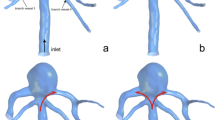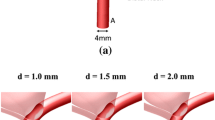Summary
A hydraulic vascular model of the vertebrobasilar artery with an autoregulatory mechanism was constructed. The haemodynamic effect of superficial temporal artery (STA)-posterior cerebral artery (PCA) bypass was investigated in cases of bilateral vertebral artery (VA) occlusion and basilar artery (BA) occlusion. Assuming therapeutic BA occlusion for basilar bifurcation aneurysms, the flow volume through the P 1 segment of the PCA was determined in relation to diameters of the posterior communicating artery (PCom).
The bypass increases both flow volume and intraluminal pressure in the pressure range below 60 mm Hg, while it increases only pressure in the autoregulatory range above 60 mm Hg. Its haemodynamic effect is more marked in BA occlusion than in VA occlusion. The averaged values of the increase in flow volume are 29.0±4.3% (mean±SD) and 16.5+1.0%, respectively. The total flow volume increase of the vertebrobasilar system is usually lower than the flow volume measured at the bypassed STA. The difference between the two is equal to the simultaneous decrease in flow volume through the PComs. Flow volume through the P1 segment can be expressed as a function of the PComs diameter ratio squared.
A hydraulic simulation study will be useful for speculating on the haemodynamic effects of these operative procedures.
Similar content being viewed by others
References
Ausman JI, Diaz FG, Reyes RA, Pak H, Patel S, Boulos R (1981) Superficial temporal to proximal superior cerebellar artery anastomosis for basilar artery stenosis. Neurosurgery 9: 56–60
Ausman JI, Diaz FG, Reyes RA, Pak H, Patel S, Mehta B, Boulos R (1982) Posterior circulation revascularization. J Neurosurg 56: 766–776
Avman N, Bering EA Jr (1961) A plastic model for the study of pressure changes in the circle of Willis and major cerebral arteries following arterial occlusion. J Neurosurg 18: 361–365
Aymard A, Gobin YP, Hodes JE, Bien S, Rufenacht D, Reizine D, George B, Merland JJ (1991) Endovascular occlusion of vertebral arteries in the treatment of unclippable vertebrobasilar aneurysms. J Neurosurg 74: 393–398
Burrow DD, Toole JF (1982) Pathophysiology and clinical evaluation of ischemic vascular disease. In: Youmans JR (ed) Neurological surgery, Vol 3. Saunders, Philadelphia, pp 1511–1558
Chang J, Roach MR (1987) Hemodynamic method to predict whether hunterian ligation of the basilar artery will lead to thrombosis of basilar bifurcation aneurysm. Neurosurgery 20: 249–253
Clark ME, Martin JD, Wenglarz RA, Himwich WA, Knapp FM (1965) Engineering analysis of the hemodynamics of the circle of Willis. Arch Neurol 13: 173–182
Debrun G, Fox AJ, Drake CG, Peerless SJ, Girvin J, Ferguson GG (1981) Giant unclippable aneurysms: treatment with detachable balloons. AJNR 2: 167–173
Drake CG (1979) The treatment of aneurysms of the posterior circulation. Clin Neurosurg 26: 96–144
Fasano VA, Portalupi A, Broggi G (1966) Study of cerebral hemodynamics by analogic models. Vascular Dis 3: 89–99
Fox AJ, Vinuela F, Pelz DM, Peerless SJ, Ferguson GG, Drake CG, Debrum G (1987) Use of detachable balloons for proximal artery occlusion in the treatment of unclippable cerebral aneurysms. J Neurosurg 66: 40–46
Hieshima CH, Higashida RT, Wapenski J, Halbach VV, Cahan LD, Bentson JR (1986) Balloon embolization of a large distal basilar artery aneurysm. J Neurosurg 65: 413–416
Higashida RT, Halbach VV, Cahan LD, Hieshima GB, Konishi Y (1989) Detachable balloon embolization therapy of posterior circulation intracranial aneurysms. J Neurosurg 71: 512–519
Himwich WA, Knapp FM, Wenglarz RA, Martin JD, Clark ME (1965) The circle of Willis as simulated by an engineering model. Arch Neurol 13: 164–172
Hopkins LN, Budny JL, Castellani D (1983) Extracranial-intracranial arterial bypass and basilar artery ligation in the treatment of giant basilar artery aneurysms. Neurosurgery 13: 189–194
Hopkins LN, Martin NA, Hadley MN, Spetzler RF, Budny J, Carter LP (1987) Vertebrobasilar insufficiency. Part 2: microsurgical treatment of intracranial vertebrobasilar disease. J Neurosurg 66: 662–674
Minakawa T, Ishii R, Tanaka R, Hayano M (1986) Basilar artery occlusion after superficial temporal artery-superior cerebellar artery anastomosis. Surg Neurol 25: 39–42
Mount LA, Taveras JM (1962) Case reports and technical note: ligation of basilar artery in treatment of an aneurysm at the basilar artery bifurcation. J Neurosurg 19: 167–170
Nagasawa S, Kikuchi H, Ohtsuki H, Moritake K, Yonekawa Y (1989) Experimental simulation study on EC-IC bypass: part 2. Hemodynamics of superficial temporal artery and clinical application of the stenosis model. Neurol Surg (Tokyo) 17: 125–132
Nagasawa S, Kikuchi H, Ohtsuki H, Nagayasu S, Moritake K, Yonekawa Y (1991) Hemodynamic study on posterior circulation with hydraulic vascular model. Critical stenosis of the vertebrobasilar artery and tolerance to the occlusion therapy. Neurol Med Chir 31: 617–622
Nagayasu S, Nagasawa S, Ohtsuki H, Kikuchi H, Siho (1991) Analysis of cerebral hemodynamics by hydraulic vascular model. Development of aneurysmal model and device for intraaneurysmal clearance. Neurosurg Lett 1: 23–28
Pelz DM, Vinuela F, Fox AJ, Drake CG (1984) Vertebrobasilar occlusion therapy of giant aneurysms. Significance of angiography of the posterior communicating arteries. J Neurosurg 60: 560–565
Rozario RA, Stein BM (1980) Ligation of the basilar artery as the definitive treatment for a giant aneurysm of the basilar artery apex. Case report. Neurosurgery 6: 87–91
Spetzler RF, Hadley MN, Nartin NA, Hopkins LN, Carter LP, Budny J (1987) Vertebrobasilar insufficiency. Part 1: microsurgical treatment of extracranial vertebrobasilar disease. J Neurosurg 66: 648–661
Sundt TM Jr, Piepgras DG (1985) Extracranial to intracranial bypass grafting: posterior circulation. In: Wilkins RHet al (eds) Neurosurgery, Vol 2. McGraw-Hill, New York, pp 1281–1292
Sundt TM Jr, Piepgras DG, Houser OW, Campbell JK (1982) Interposition saphenous vein grafts for advanced occlusive disease and large aneurysms in the posterior circulation. J Neurosurg 56: 205–215
Yaşargil MG, Antic J, Laciga R, Jain KK, Hodosh RM, Smith RD (1979) Microsurgical pterional approach to aneurysms of the basilar bifurcation. Surg Neurol 6: 83–91
Youmans JR (1982) Cerebral blood flow in clinical problems. In: Youmans JR (ed) Neurological surgery, Vol 2. Saunders, Philadelphia, pp 786–845
Author information
Authors and Affiliations
Rights and permissions
About this article
Cite this article
Nagasawa, S., Ohta, T., Kikuchi, H. et al. Simulation study on bypass and therapeutic occlusion in the posterior circulation. Acta neurochir 132, 120–126 (1995). https://doi.org/10.1007/BF01404858
Issue Date:
DOI: https://doi.org/10.1007/BF01404858




